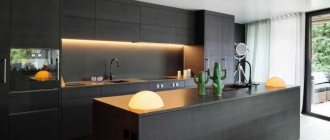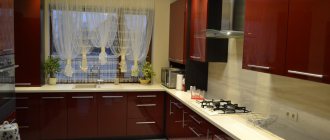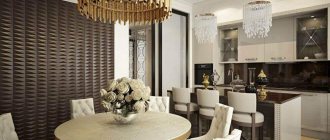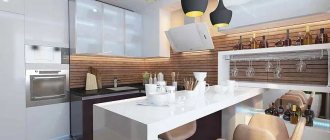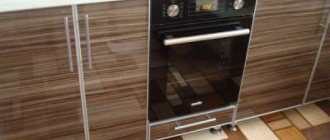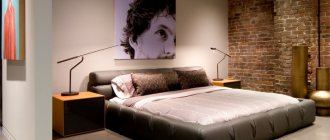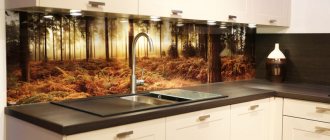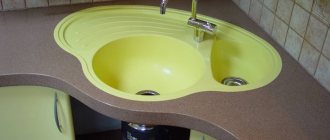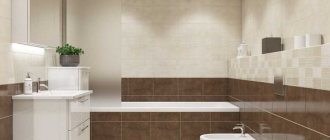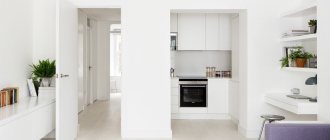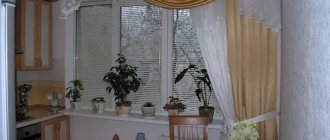Common questions and answers
Q: How can I additionally protect wooden lining from moisture?
A: The installation of sheets and the type of lock on them plays a big role. Vertical installation allows moisture to quickly flow down the surface onto the floor without accumulating in the lock or other cavities. The figured tongue-and-groove lock also helps protect the interior wall from liquids.
Q: Is it possible to install soundproofing or insulation under a wall made of plastic lining?
A: This is a possible option not only for plastic lining. There are two types of fastening materials in this case: serial and parallel.
READ MORE: Installing a siphon with your own hands on a bathtub sink and kitchen sink
During sequential installation, the lining sheets are attached to an already installed sound or heat insulating coating on an additional mounting frame. This is a complex procedure that requires not only a skilled craftsman, but also a special, durable frame.
Parallel installation is carried out using one mounting frame made of a metal profile or a wooden beam. This method is relevant for wall insulation, but is poorly suited for sound insulation, since the vibration lining will not be able to support the weight of sound insulation and wooden lining at the same time, and will quickly lose its vibration damping properties.
It is also worth thinking about the advisability of attaching the lining to sound insulation. A good alternative would be soundproofing plastic-coated plasterboard.
Q: What design should I choose for a country house?
A: Wooden lining is best suited for rooms where people stay for one or two seasons a year. It has an authentic appearance, its processing and use have no limits. Decorating a kitchen with wooden paneling in a private or country house can be different; you can see the common types in the photo.
Q: Is it worth the risk with MDF paneling?
A: MDF is a promising material. Experts believe that in the coming years, production facilities specializing in the production of high-quality MDF lining will appear in our country. The use of new technologies can improve its performance. At the moment, it is impossible to unequivocally recommend MDF as a profitable option, but in a few years this type of finishing material may leave its competitors far behind.
Q: How to calculate the cost of repairs?
A: On online trading platforms or warehouses you can use a construction calculator. All you need to know is the size of the room, the type of walls (brick, concrete, aerated concrete), as well as the readiness of the walls for repair - the presence of cracks, irregularities, etc., which can add several thousand to the repair costs.
Lining in the kitchen: for which styles?
First of all, wooden cladding of walls and ceilings is relevant for country or cottage (“dacha”) style. Here the lining can be left unpainted. If we are talking about the Provence style, which is distinguished by its special softness and grace, it is better to paint the board.
Country style kitchen in an apartment. Design: Perm studio Laboratory 22
Kitchen in the country. Design: More Decor bureau for the “Dachny Otvet” program
The use of lining is widespread in Scandinavia. Most often, it is used to cover the walls inside private houses, but the board can also be found in the interiors of city apartments. Both walls and ceilings are covered with lining. In most cases, the board is painted white. Scandinavian style is now very popular in the world, including here. Hence the increased interest in lining as a material for interior decoration.
White lining in a Scandinavian kitchen
The lining is also harmonious in the so-called eco-design. If you need to bring natural motifs into the interior, you can’t do without wood.
Wood paneling is appropriate even in modern classics. But here it is used mainly in the form of panels and always in painted form.
Types of material
When choosing a finishing material, you need to pay attention to the fact that the lining can be made from different types of wood. Depending on the chosen variety, the price of the boards and their appearance will change. The following types of lining can be found on sale:
- Pine is the cheapest and does not have the most beautiful texture. However, this option is excellent as a material for painting.
- Linden board is not too expensive, but has excellent resistance to moisture. Disadvantage: it darkens very quickly and needs special treatment to avoid this.
- Made from spruce. Not very durable, with a beautiful texture without a strong pattern. Spruce wood can absorb moisture and therefore necessarily needs to be treated with special compounds.
- Larch. One of the most moisture-resistant breeds, but very expensive. Very beautiful and durable larch wood allows you to get a beautiful coating without painting.
- Cedar. The exceptionally beautiful textured pattern on the boards cannot be painted over - why hide such beauty. However, you have to pay for this - the cost of cedar lining is very high. The advantages include the fact that there will be no mosquitoes in a room with such finishing - they cannot tolerate the characteristic smell of cedar wood.
- Alder planks do not absorb moisture and can be an ideal solution for the kitchen. They are not too expensive and have good durability. The disadvantages include the short service life of the coating, which is solved by impregnations that keep the alder surface in excellent condition for a long time.
Oak is rarely used as a kitchen finish, as it is one of the most expensive types of wood with a very beautiful texture. High strength, long service life and appearance have a significant impact on this material, but there is another parameter that makes oak boards a very expensive material - the length and width of the parts. The wider and longer the lining, the more expensive you will have to pay.
In addition, the lining differs in the shape of the parts. There are several main types of lamella profiles that allow you to obtain surfaces with different appearances:
- Standard
- Softline
- Block house
- American
- Landhouse
All of them are presented in the figure below, from which you can understand the difference between the types of parts. Choosing the right one will not be difficult - only a few of them are suitable for ceilings.
Types of lining
Before choosing a certain type of lining, you need to understand what they are and what the differences are (also find out how to decorate the walls in the kitchen).
PVC (plastic)
Colored plastic lining.
PVC (plastic) lining is intended for finishing walls and ceilings; it is produced without patterns, but can be of different colors.
It is this modern material that allows you to get tangible savings when finishing walls and ceilings. PVC lining, the price of which is significantly low and pleases potential buyers, is perfect for installation in any room, including the kitchen.
Wooden
Wooden lining is divided into classes:
- Extra, completely free of knots and defects;
- A – only light live knots are possible, no more than one per 1.5 meters in length;
- B – knots can be dark, no more than four per 1.5 meters in length;
- C – knots may fall out.
Naturally, the higher the class, the better the quality of the material.
Important. To cover walls in the kitchen, as in other rooms, use only well-dried boards; its humidity should not exceed 15%. The ideal option is material treated with an antifungal compound and dried in an autoclave.
Features of plastic lining
Polymers are good for the kitchen. These materials meet all the requirements for finishing in this room. Owners of kitchen units whose facades are lined with plastic panels know how easy it is to care for such surfaces. They were convinced of their ability to maintain their original appearance for a long time under difficult operating conditions.
A kitchen finished with plastic clapboard can have any design style. Polymers are easily painted and molded, which provides manufacturers with unlimited possibilities. You can choose from a range of slats:
- glossy and matte;
- smooth and textured;
- plain, imitating wood, stone.
Plastic lining will retain its original appearance for a long time
This category of products is presented in a wide range of colors. It is possible to make the perfect choice, focusing on the features of the interior. Photos of kitchen designs made from this type of lining will help you make a good choice.
The advantage of plastic is its resistance to moisture, sunlight, and temperatures. The structure of the material is preserved for several years, surfaces can be cleaned with detergents. The kitchen can be finished with clapboards in an apartment or cottage or unheated country house.
Plastic lining can be cleaned with detergents
Polyvinyl chloride strips can be mounted on any surface. They have minimal weight and do not create a load on the base. The surface is highly durable and is not damaged by accidental mechanical impacts. In the photo of finishing the kitchen with clapboard you can see horizontal and vertical installation options. With the help of proper placement of lamellas, you can visually enlarge or reduce the room.
Plastic lining has minimal weight
If the design project includes a clapboard kitchen apron, the plastic option will be the best solution. The smooth, durable surface of the lamellas will ensure simplicity and ease of maintenance.
Advantages and disadvantages of using lining for ceiling finishing
The presented material is divided into several types. The advantages and disadvantages are determined by the type of wood from which the lining was made. She may be:
- Sosnovaya;
- Dubovoy;
- Lipova;
- From larch;
- From aspen;
- From spruce.
What does lining look like from different types of wood?
The most inexpensive and common type of lining is pine. This product is distinguished by a variety of colors and an optimal price-quality ratio. The kitchen ceiling, finished with this material, will have a light yellow color. Its only drawback is the need to apply varnish or paint to the surface, otherwise the product quickly loses its original rich color.
The kitchen ceiling can be finished with oak lining, which is highly resistant to rotting and can easily be subjected to any type of processing. Among other advantages, it is worth noting the original surface structure and the optionality of staining and etching of the product. One drawback is the high cost of such finishing material.
The most significant advantage of the presented wooden product is that it can help visually level the surface of any ceiling and create an attractive and aesthetic decor. The lining compares favorably:
- High degree of moisture resistance (after varnishing);
- Durability;
- Versatility;
- Long service life;
- Good sound and heat insulation.
Among the disadvantages, it should be noted an increased fire hazard, which can be reduced by treating the surface with a special fire-retardant impregnation. In addition, such wooden finishing must be comprehensively treated with substances that prevent the growth of fungal mold and harmful insects. The material has low resistance to temperature changes and high humidity, as a result of which its surface may be subject to deformation. To increase moisture resistance, the product can be treated with varnish.
Work order
Having decided on the type of wood and the shape of the lining from which the wooden ceiling in the kitchen will be assembled, you can proceed directly to purchasing the material and assembling the structure. It all starts with the installation of the sheathing, to which the covering fragments will be attached. It can be assembled from any wooden slats, bars or metal profiles that are used to assemble gypsum plasterboard structures.
Important: all wiring and other communications must be laid before sheathing the sheathing with boards.
Having assembled the base, it is sheathed with wooden strips, previously sawn to size. The easiest way to fasten the lining is with nails driven at an angle at the junction of two adjacent parts or with special fasteners - clamps. The parts are connected to each other using the tongue and groove method. The last stage of assembling the structure will be the treatment of the coating with stains, staining or treatment with a special wax that resists moisture and gives the wood a beautiful appearance.
